Exploring Leadership, Management, Globalisation & CSR in Business
VerifiedAdded on 2024/07/12
|15
|2916
|355
Report
AI Summary
This business report explores the roles, types, and styles of management and leadership, underpinned by relevant theories. It identifies and explains the three levels of an organization, including functional areas, with specific reference to Mitsubishi Motors. The report discusses the drivers of globalisation and electronic business, highlighting their influence on organizations. Key issues in contemporary business and management are identified and discussed, along with an understanding of functional areas and the tactical, strategic, and operational hierarchy of management. Finally, it suggests why CSR and globalisation are key themes to be considered in leadership and management positions, emphasizing the importance of adapting leadership styles to situational changes and stakeholder expectations.
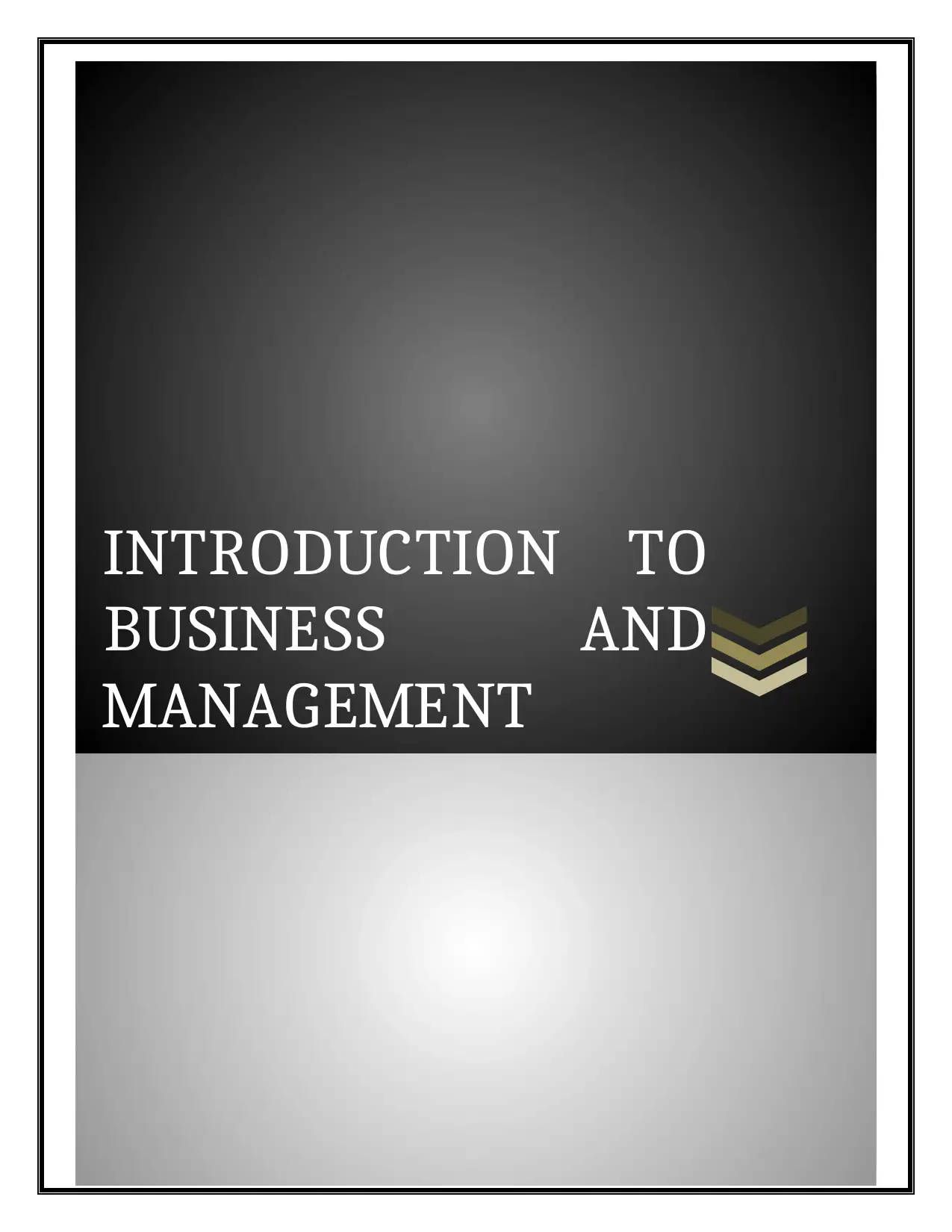
INTRODUCTION TO
BUSINESS AND
MANAGEMENT
BUSINESS AND
MANAGEMENT
Paraphrase This Document
Need a fresh take? Get an instant paraphrase of this document with our AI Paraphraser
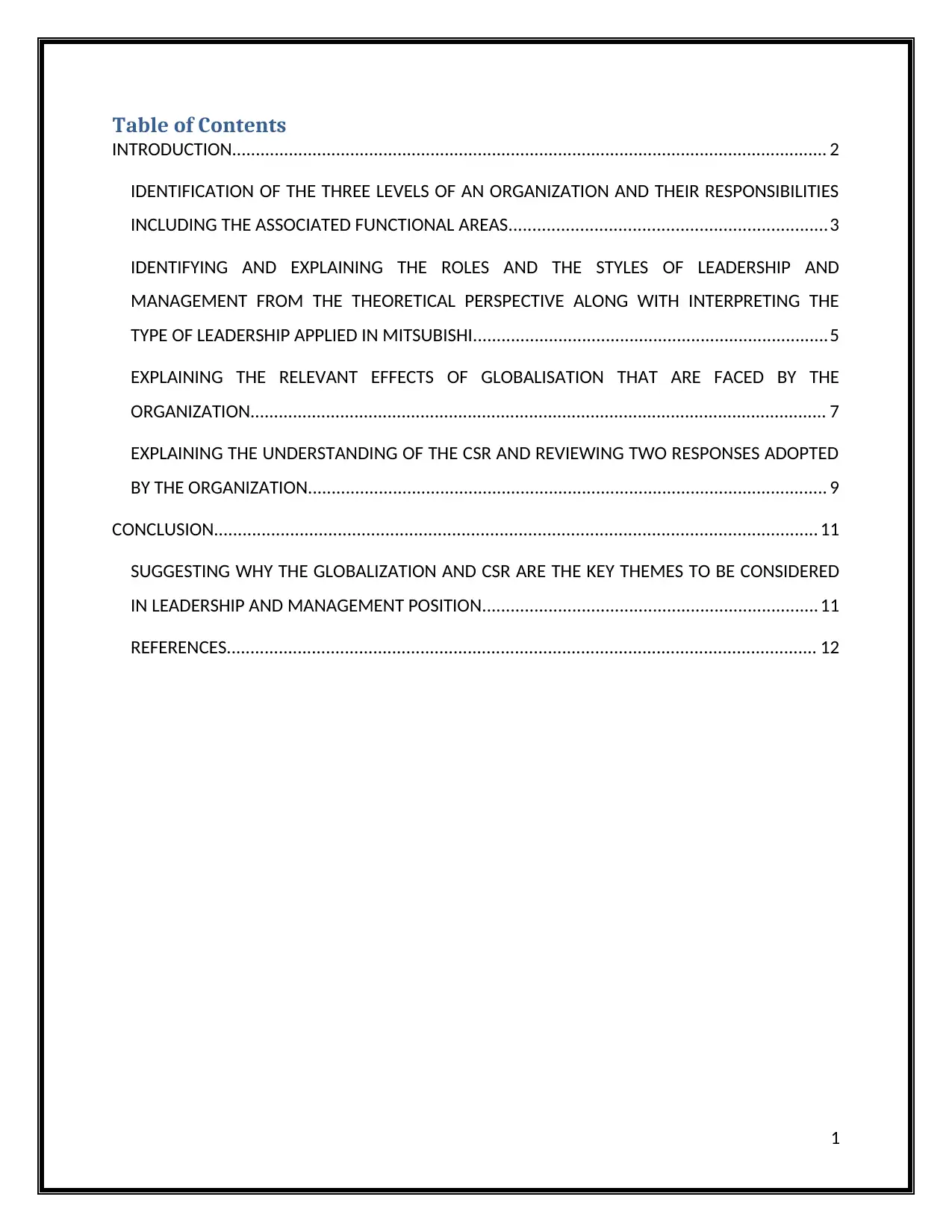
Table of Contents
INTRODUCTION.............................................................................................................................. 2
IDENTIFICATION OF THE THREE LEVELS OF AN ORGANIZATION AND THEIR RESPONSIBILITIES
INCLUDING THE ASSOCIATED FUNCTIONAL AREAS...................................................................3
IDENTIFYING AND EXPLAINING THE ROLES AND THE STYLES OF LEADERSHIP AND
MANAGEMENT FROM THE THEORETICAL PERSPECTIVE ALONG WITH INTERPRETING THE
TYPE OF LEADERSHIP APPLIED IN MITSUBISHI...........................................................................5
EXPLAINING THE RELEVANT EFFECTS OF GLOBALISATION THAT ARE FACED BY THE
ORGANIZATION.......................................................................................................................... 7
EXPLAINING THE UNDERSTANDING OF THE CSR AND REVIEWING TWO RESPONSES ADOPTED
BY THE ORGANIZATION.............................................................................................................. 9
CONCLUSION............................................................................................................................... 11
SUGGESTING WHY THE GLOBALIZATION AND CSR ARE THE KEY THEMES TO BE CONSIDERED
IN LEADERSHIP AND MANAGEMENT POSITION....................................................................... 11
REFERENCES............................................................................................................................. 12
1
INTRODUCTION.............................................................................................................................. 2
IDENTIFICATION OF THE THREE LEVELS OF AN ORGANIZATION AND THEIR RESPONSIBILITIES
INCLUDING THE ASSOCIATED FUNCTIONAL AREAS...................................................................3
IDENTIFYING AND EXPLAINING THE ROLES AND THE STYLES OF LEADERSHIP AND
MANAGEMENT FROM THE THEORETICAL PERSPECTIVE ALONG WITH INTERPRETING THE
TYPE OF LEADERSHIP APPLIED IN MITSUBISHI...........................................................................5
EXPLAINING THE RELEVANT EFFECTS OF GLOBALISATION THAT ARE FACED BY THE
ORGANIZATION.......................................................................................................................... 7
EXPLAINING THE UNDERSTANDING OF THE CSR AND REVIEWING TWO RESPONSES ADOPTED
BY THE ORGANIZATION.............................................................................................................. 9
CONCLUSION............................................................................................................................... 11
SUGGESTING WHY THE GLOBALIZATION AND CSR ARE THE KEY THEMES TO BE CONSIDERED
IN LEADERSHIP AND MANAGEMENT POSITION....................................................................... 11
REFERENCES............................................................................................................................. 12
1

Figure 1- Organizational Levels...................................................................................................... 4
2
2
⊘ This is a preview!⊘
Do you want full access?
Subscribe today to unlock all pages.

Trusted by 1+ million students worldwide
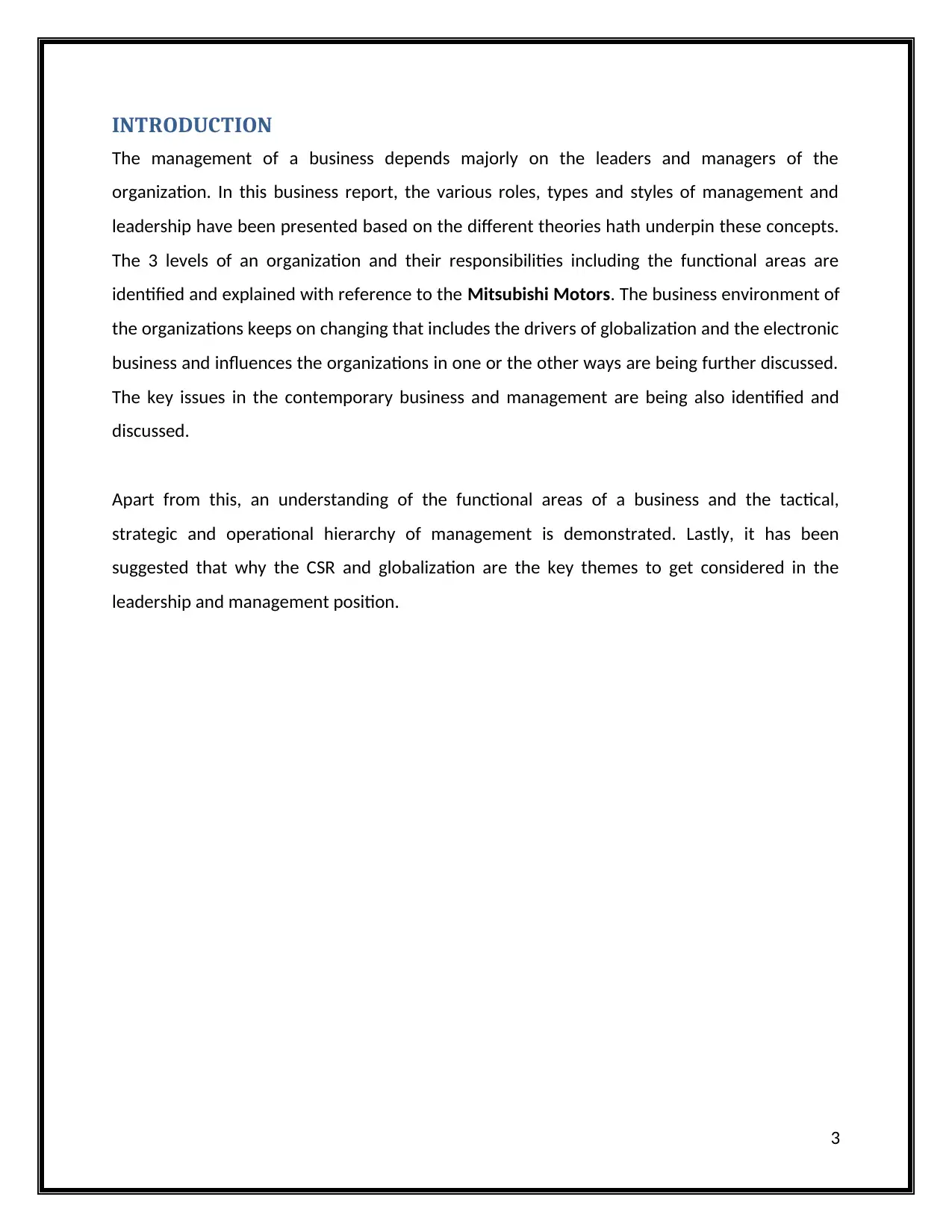
INTRODUCTION
The management of a business depends majorly on the leaders and managers of the
organization. In this business report, the various roles, types and styles of management and
leadership have been presented based on the different theories hath underpin these concepts.
The 3 levels of an organization and their responsibilities including the functional areas are
identified and explained with reference to the Mitsubishi Motors. The business environment of
the organizations keeps on changing that includes the drivers of globalization and the electronic
business and influences the organizations in one or the other ways are being further discussed.
The key issues in the contemporary business and management are being also identified and
discussed.
Apart from this, an understanding of the functional areas of a business and the tactical,
strategic and operational hierarchy of management is demonstrated. Lastly, it has been
suggested that why the CSR and globalization are the key themes to get considered in the
leadership and management position.
3
The management of a business depends majorly on the leaders and managers of the
organization. In this business report, the various roles, types and styles of management and
leadership have been presented based on the different theories hath underpin these concepts.
The 3 levels of an organization and their responsibilities including the functional areas are
identified and explained with reference to the Mitsubishi Motors. The business environment of
the organizations keeps on changing that includes the drivers of globalization and the electronic
business and influences the organizations in one or the other ways are being further discussed.
The key issues in the contemporary business and management are being also identified and
discussed.
Apart from this, an understanding of the functional areas of a business and the tactical,
strategic and operational hierarchy of management is demonstrated. Lastly, it has been
suggested that why the CSR and globalization are the key themes to get considered in the
leadership and management position.
3
Paraphrase This Document
Need a fresh take? Get an instant paraphrase of this document with our AI Paraphraser
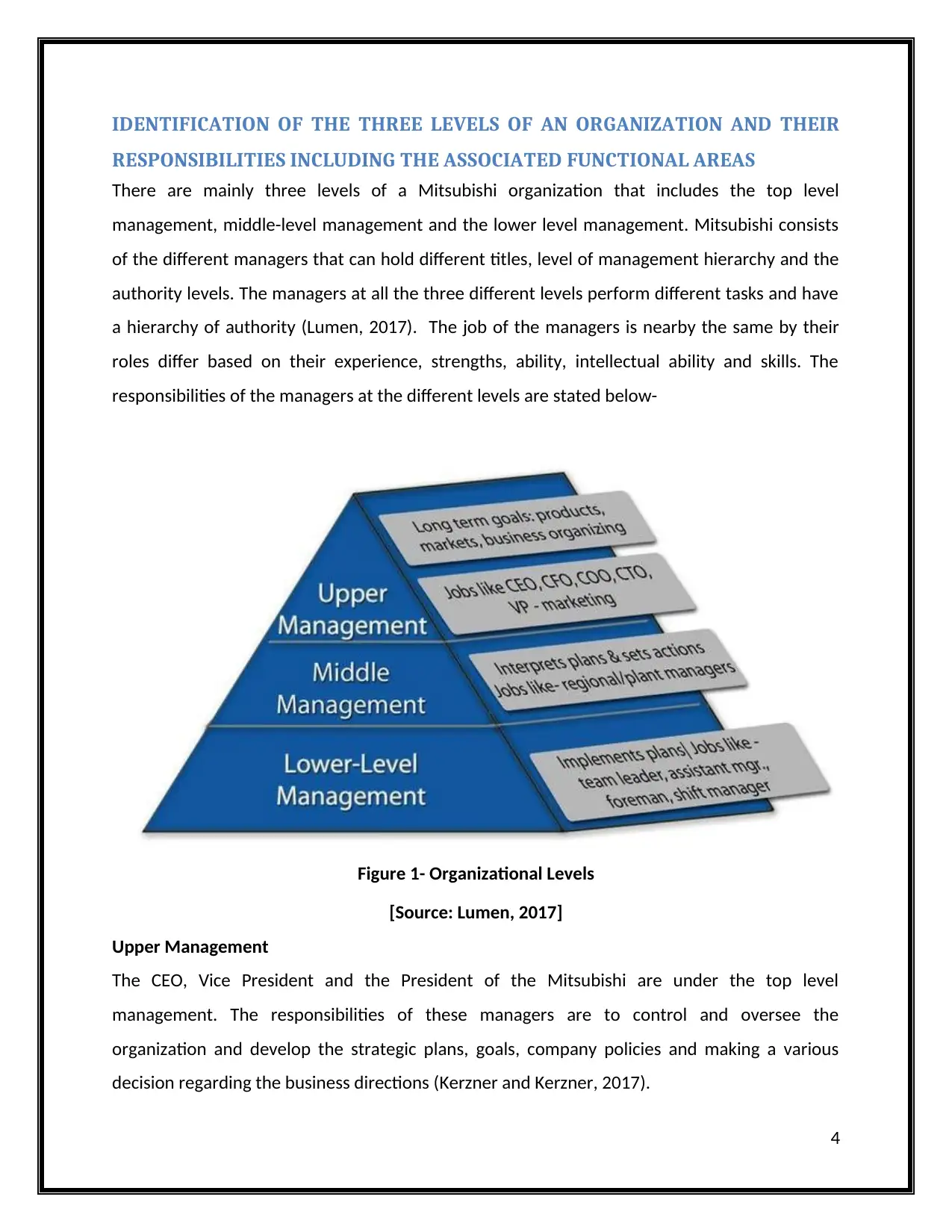
IDENTIFICATION OF THE THREE LEVELS OF AN ORGANIZATION AND THEIR
RESPONSIBILITIES INCLUDING THE ASSOCIATED FUNCTIONAL AREAS
There are mainly three levels of a Mitsubishi organization that includes the top level
management, middle-level management and the lower level management. Mitsubishi consists
of the different managers that can hold different titles, level of management hierarchy and the
authority levels. The managers at all the three different levels perform different tasks and have
a hierarchy of authority (Lumen, 2017). The job of the managers is nearby the same by their
roles differ based on their experience, strengths, ability, intellectual ability and skills. The
responsibilities of the managers at the different levels are stated below-
Figure 1- Organizational Levels
[Source: Lumen, 2017]
Upper Management
The CEO, Vice President and the President of the Mitsubishi are under the top level
management. The responsibilities of these managers are to control and oversee the
organization and develop the strategic plans, goals, company policies and making a various
decision regarding the business directions (Kerzner and Kerzner, 2017).
4
RESPONSIBILITIES INCLUDING THE ASSOCIATED FUNCTIONAL AREAS
There are mainly three levels of a Mitsubishi organization that includes the top level
management, middle-level management and the lower level management. Mitsubishi consists
of the different managers that can hold different titles, level of management hierarchy and the
authority levels. The managers at all the three different levels perform different tasks and have
a hierarchy of authority (Lumen, 2017). The job of the managers is nearby the same by their
roles differ based on their experience, strengths, ability, intellectual ability and skills. The
responsibilities of the managers at the different levels are stated below-
Figure 1- Organizational Levels
[Source: Lumen, 2017]
Upper Management
The CEO, Vice President and the President of the Mitsubishi are under the top level
management. The responsibilities of these managers are to control and oversee the
organization and develop the strategic plans, goals, company policies and making a various
decision regarding the business directions (Kerzner and Kerzner, 2017).
4

Media Management
The managers of the different departments of Mitsubishi, general managers and the branch
manager's together constitute the middle-level managers and are accountable to top
management in their departmental functions. They execute the organizational plans of the
company, define and discuss the information and policies from the top to lower management
and inspired the lower team managers to perform better (Thompson, 2017).
Lower-level Management
The lower management of the Mitsubishi includes the section leads, supervisors and the
foreman who majorly focus on directing and controlling. They assign tasks to the employees,
guides and supervise them in their day to day activities, ensure the quality of electric vehicles
and motors along with their production and making suggestions and recommendations.
The functional management of the Mitsubishi is mainly focused on the execution of the specific
tasks of the organization related to functional areas such as the product planning development,
design and the purchasing of the new models with the help of organizing and leading an
organizational talent. The functional managers have high skills and technical knowledge in the
area which they are managing and giver extra efforts to achieve best practices. For example,
the product planning manager has to look after the scope of the new product of the company,
its essential features and they would also define the resources required for it (Wheelen, et al.
2017).
5
The managers of the different departments of Mitsubishi, general managers and the branch
manager's together constitute the middle-level managers and are accountable to top
management in their departmental functions. They execute the organizational plans of the
company, define and discuss the information and policies from the top to lower management
and inspired the lower team managers to perform better (Thompson, 2017).
Lower-level Management
The lower management of the Mitsubishi includes the section leads, supervisors and the
foreman who majorly focus on directing and controlling. They assign tasks to the employees,
guides and supervise them in their day to day activities, ensure the quality of electric vehicles
and motors along with their production and making suggestions and recommendations.
The functional management of the Mitsubishi is mainly focused on the execution of the specific
tasks of the organization related to functional areas such as the product planning development,
design and the purchasing of the new models with the help of organizing and leading an
organizational talent. The functional managers have high skills and technical knowledge in the
area which they are managing and giver extra efforts to achieve best practices. For example,
the product planning manager has to look after the scope of the new product of the company,
its essential features and they would also define the resources required for it (Wheelen, et al.
2017).
5
⊘ This is a preview!⊘
Do you want full access?
Subscribe today to unlock all pages.

Trusted by 1+ million students worldwide
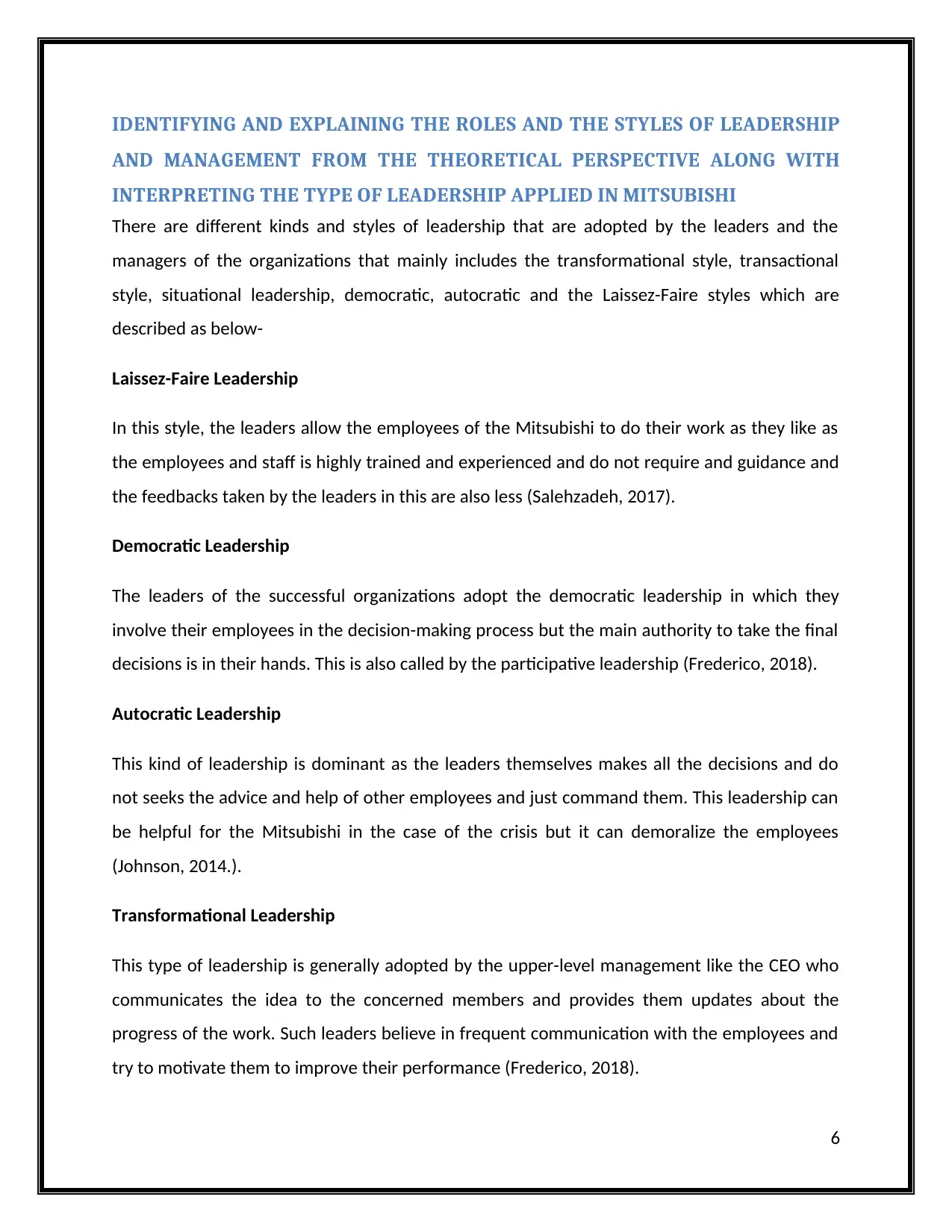
IDENTIFYING AND EXPLAINING THE ROLES AND THE STYLES OF LEADERSHIP
AND MANAGEMENT FROM THE THEORETICAL PERSPECTIVE ALONG WITH
INTERPRETING THE TYPE OF LEADERSHIP APPLIED IN MITSUBISHI
There are different kinds and styles of leadership that are adopted by the leaders and the
managers of the organizations that mainly includes the transformational style, transactional
style, situational leadership, democratic, autocratic and the Laissez-Faire styles which are
described as below-
Laissez-Faire Leadership
In this style, the leaders allow the employees of the Mitsubishi to do their work as they like as
the employees and staff is highly trained and experienced and do not require and guidance and
the feedbacks taken by the leaders in this are also less (Salehzadeh, 2017).
Democratic Leadership
The leaders of the successful organizations adopt the democratic leadership in which they
involve their employees in the decision-making process but the main authority to take the final
decisions is in their hands. This is also called by the participative leadership (Frederico, 2018).
Autocratic Leadership
This kind of leadership is dominant as the leaders themselves makes all the decisions and do
not seeks the advice and help of other employees and just command them. This leadership can
be helpful for the Mitsubishi in the case of the crisis but it can demoralize the employees
(Johnson, 2014.).
Transformational Leadership
This type of leadership is generally adopted by the upper-level management like the CEO who
communicates the idea to the concerned members and provides them updates about the
progress of the work. Such leaders believe in frequent communication with the employees and
try to motivate them to improve their performance (Frederico, 2018).
6
AND MANAGEMENT FROM THE THEORETICAL PERSPECTIVE ALONG WITH
INTERPRETING THE TYPE OF LEADERSHIP APPLIED IN MITSUBISHI
There are different kinds and styles of leadership that are adopted by the leaders and the
managers of the organizations that mainly includes the transformational style, transactional
style, situational leadership, democratic, autocratic and the Laissez-Faire styles which are
described as below-
Laissez-Faire Leadership
In this style, the leaders allow the employees of the Mitsubishi to do their work as they like as
the employees and staff is highly trained and experienced and do not require and guidance and
the feedbacks taken by the leaders in this are also less (Salehzadeh, 2017).
Democratic Leadership
The leaders of the successful organizations adopt the democratic leadership in which they
involve their employees in the decision-making process but the main authority to take the final
decisions is in their hands. This is also called by the participative leadership (Frederico, 2018).
Autocratic Leadership
This kind of leadership is dominant as the leaders themselves makes all the decisions and do
not seeks the advice and help of other employees and just command them. This leadership can
be helpful for the Mitsubishi in the case of the crisis but it can demoralize the employees
(Johnson, 2014.).
Transformational Leadership
This type of leadership is generally adopted by the upper-level management like the CEO who
communicates the idea to the concerned members and provides them updates about the
progress of the work. Such leaders believe in frequent communication with the employees and
try to motivate them to improve their performance (Frederico, 2018).
6
Paraphrase This Document
Need a fresh take? Get an instant paraphrase of this document with our AI Paraphraser

Transactional Leadership
Transactional style of leaders believes in offering rewards and punishments to the employees
based on their performance in the work and on how well they have accomplished the goals and
objectives. Bonuses and incentives are provided by such leaders to encourage them (Nia and
Nia, 2016).
Situational Leadership
The leaders with the situational style offer support and guidance to the employees to help them
in the attainment of the organizational aims and objectives. Such leaders are the driving force
of the team and take the whole team together and also offer extra support to the employees
who need it. When the certain procedures like painting the cars required the fine-tuning or
refinement of situational leadership can be applied by the leaders of Mitsubishi.
Based on the theoretical perspective of leadership, it can be interpreted that the situational
leadership is applied in the workforce as the situations based on the response of the customers
towards the products of the Mitsubishi keeps on changing so it is required by leaders to change
their leadership style based on situations. Democratic leadership is also used by the Mitsubishi
leaders as they involve the employees in the decision making of the company (Johnson, 2014).
7
Transactional style of leaders believes in offering rewards and punishments to the employees
based on their performance in the work and on how well they have accomplished the goals and
objectives. Bonuses and incentives are provided by such leaders to encourage them (Nia and
Nia, 2016).
Situational Leadership
The leaders with the situational style offer support and guidance to the employees to help them
in the attainment of the organizational aims and objectives. Such leaders are the driving force
of the team and take the whole team together and also offer extra support to the employees
who need it. When the certain procedures like painting the cars required the fine-tuning or
refinement of situational leadership can be applied by the leaders of Mitsubishi.
Based on the theoretical perspective of leadership, it can be interpreted that the situational
leadership is applied in the workforce as the situations based on the response of the customers
towards the products of the Mitsubishi keeps on changing so it is required by leaders to change
their leadership style based on situations. Democratic leadership is also used by the Mitsubishi
leaders as they involve the employees in the decision making of the company (Johnson, 2014).
7

EXPLAINING THE RELEVANT EFFECTS OF GLOBALISATION THAT ARE FACED
BY THE ORGANIZATION
The car industry has been continuously getting globalized day by day and the competition is
getting fierce between the different countries to produce better cars and obtain huge finance to
manufacture. There are various impacts of the globalization that is organizations are being
focusing. The relevant effects are described below-
Increased competition
The competition for the organizations have been increased as more foreign investments has
been flowing into countries, de-regulation occurs that allows the business to enter into the
markets from where they have been once prohibited (Czaika and Neumayer, 2017).
Greater awareness
Greater awareness in the customers has been created as the customers in the present scenario
have become more selective in the essentials such as the service, quality and price
Economies of scale
The businesses can acquire the economies of large-scale production by selling their products
and services across the various continents. This helps in making the organizations competitive.
Location flexibility
Almost everywhere the different modern production techniques and services provisions can be
allocated which allows the companies to attain the advantage of the resources charges along
with the low-cost labour (Czaika and Neumayer, 2017).
Increased mergers and joint ventures
The organizations have been increasingly merging up with the other organizations and
establishing joint ventures that result in the access to the bigger markets and cost advantages
that are associated with it.
8
BY THE ORGANIZATION
The car industry has been continuously getting globalized day by day and the competition is
getting fierce between the different countries to produce better cars and obtain huge finance to
manufacture. There are various impacts of the globalization that is organizations are being
focusing. The relevant effects are described below-
Increased competition
The competition for the organizations have been increased as more foreign investments has
been flowing into countries, de-regulation occurs that allows the business to enter into the
markets from where they have been once prohibited (Czaika and Neumayer, 2017).
Greater awareness
Greater awareness in the customers has been created as the customers in the present scenario
have become more selective in the essentials such as the service, quality and price
Economies of scale
The businesses can acquire the economies of large-scale production by selling their products
and services across the various continents. This helps in making the organizations competitive.
Location flexibility
Almost everywhere the different modern production techniques and services provisions can be
allocated which allows the companies to attain the advantage of the resources charges along
with the low-cost labour (Czaika and Neumayer, 2017).
Increased mergers and joint ventures
The organizations have been increasingly merging up with the other organizations and
establishing joint ventures that result in the access to the bigger markets and cost advantages
that are associated with it.
8
⊘ This is a preview!⊘
Do you want full access?
Subscribe today to unlock all pages.

Trusted by 1+ million students worldwide
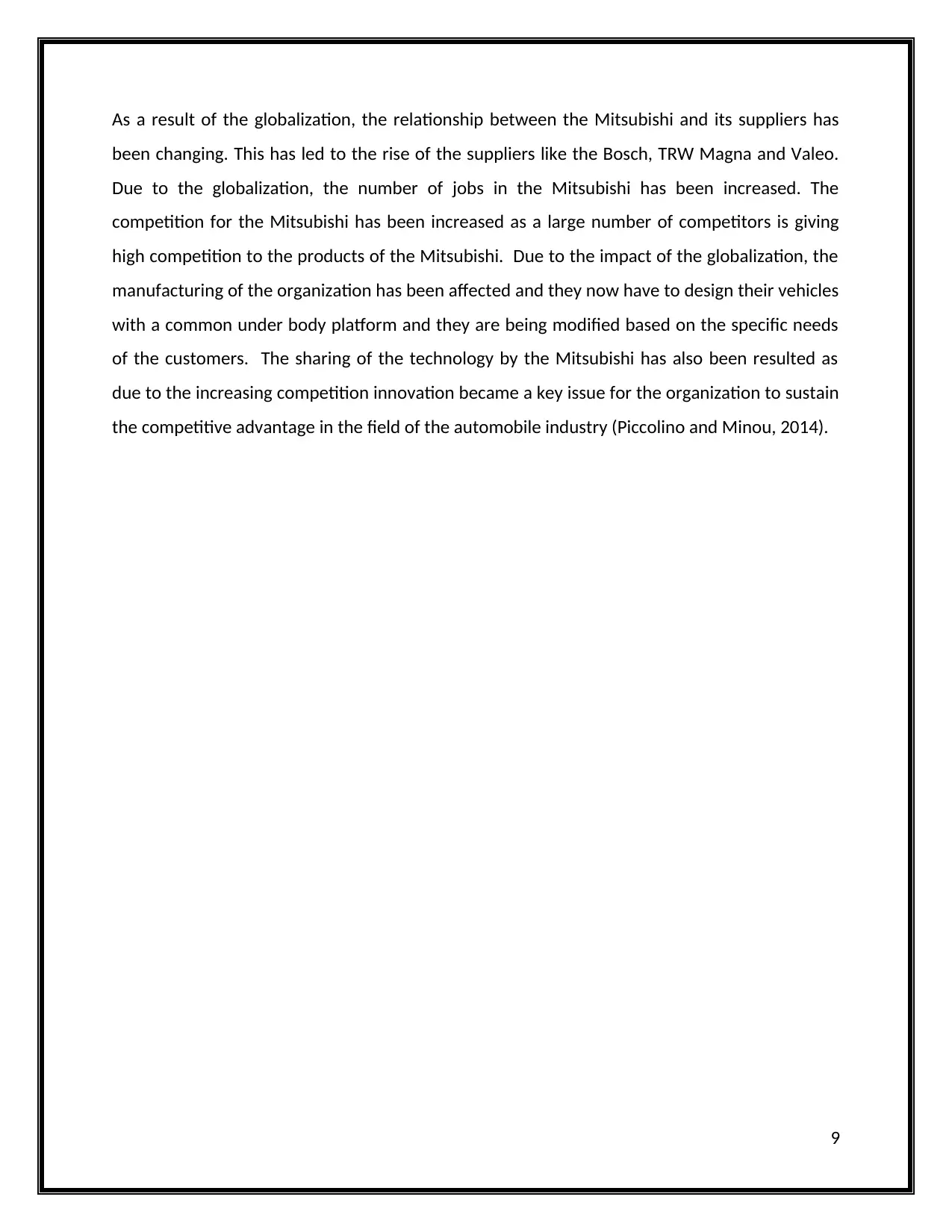
As a result of the globalization, the relationship between the Mitsubishi and its suppliers has
been changing. This has led to the rise of the suppliers like the Bosch, TRW Magna and Valeo.
Due to the globalization, the number of jobs in the Mitsubishi has been increased. The
competition for the Mitsubishi has been increased as a large number of competitors is giving
high competition to the products of the Mitsubishi. Due to the impact of the globalization, the
manufacturing of the organization has been affected and they now have to design their vehicles
with a common under body platform and they are being modified based on the specific needs
of the customers. The sharing of the technology by the Mitsubishi has also been resulted as
due to the increasing competition innovation became a key issue for the organization to sustain
the competitive advantage in the field of the automobile industry (Piccolino and Minou, 2014).
9
been changing. This has led to the rise of the suppliers like the Bosch, TRW Magna and Valeo.
Due to the globalization, the number of jobs in the Mitsubishi has been increased. The
competition for the Mitsubishi has been increased as a large number of competitors is giving
high competition to the products of the Mitsubishi. Due to the impact of the globalization, the
manufacturing of the organization has been affected and they now have to design their vehicles
with a common under body platform and they are being modified based on the specific needs
of the customers. The sharing of the technology by the Mitsubishi has also been resulted as
due to the increasing competition innovation became a key issue for the organization to sustain
the competitive advantage in the field of the automobile industry (Piccolino and Minou, 2014).
9
Paraphrase This Document
Need a fresh take? Get an instant paraphrase of this document with our AI Paraphraser

EXPLAINING THE UNDERSTANDING OF THE CSR AND REVIEWING TWO
RESPONSES ADOPTED BY THE ORGANIZATION
Corporate Social Responsibility or the CSR can be defined as one of the business approaches
that help an organization to attain sustainable development by the delivery of the social,
economic and the environmental benefits to their stakeholders. It addresses various topics
related to corporate governance, human rights, environmental effects, health and safety, the
working condition along with the contribution to the economic development of the
organization. With the help of the CSR programs, volunteer efforts and philanthropy the
organizations are benefiting the society while boosting their brands. The use of the CSR
practices in the organization helps in the development of a strong bond between the
corporation and the employees (Jang and Ardichvili, 2015).
An organization looking forward to becoming socially responsible needs to first become
responsible for itself along with its stakeholders. This kind of strategy is adopted by the large
organizations like the Mitsubishi which is reached a stage where it can contribute to the
society. Mitsubishi has set standards of ethical behaviour in the organization for its
competitors, peers and the industry (Petrenko, et al. 2016).
RESPONSES ADOPTED BY THE MITSUBISHI FOR THE IMPLEMENTATION OF THE CSR PRACTICES
Mitsubishi has maintained a strong communication and relationship with its stakeholders for
the attainment of sustainable growth in the business. The organization has taken the
responsibility of the incorporation of the expectations, requests along with the opinions of the
stakeholders into its corporate activities so as to maximize the positive impacts and minimize
the negative impacts on the society (de Jong et al. 2017). The company upholds the “Four
Satisfactions” management policy so as to provide satisfaction to its various stakeholders,
shareholders, Society as well as the employees. The following practices are adopted by
Mitsubishi-
10
RESPONSES ADOPTED BY THE ORGANIZATION
Corporate Social Responsibility or the CSR can be defined as one of the business approaches
that help an organization to attain sustainable development by the delivery of the social,
economic and the environmental benefits to their stakeholders. It addresses various topics
related to corporate governance, human rights, environmental effects, health and safety, the
working condition along with the contribution to the economic development of the
organization. With the help of the CSR programs, volunteer efforts and philanthropy the
organizations are benefiting the society while boosting their brands. The use of the CSR
practices in the organization helps in the development of a strong bond between the
corporation and the employees (Jang and Ardichvili, 2015).
An organization looking forward to becoming socially responsible needs to first become
responsible for itself along with its stakeholders. This kind of strategy is adopted by the large
organizations like the Mitsubishi which is reached a stage where it can contribute to the
society. Mitsubishi has set standards of ethical behaviour in the organization for its
competitors, peers and the industry (Petrenko, et al. 2016).
RESPONSES ADOPTED BY THE MITSUBISHI FOR THE IMPLEMENTATION OF THE CSR PRACTICES
Mitsubishi has maintained a strong communication and relationship with its stakeholders for
the attainment of sustainable growth in the business. The organization has taken the
responsibility of the incorporation of the expectations, requests along with the opinions of the
stakeholders into its corporate activities so as to maximize the positive impacts and minimize
the negative impacts on the society (de Jong et al. 2017). The company upholds the “Four
Satisfactions” management policy so as to provide satisfaction to its various stakeholders,
shareholders, Society as well as the employees. The following practices are adopted by
Mitsubishi-
10
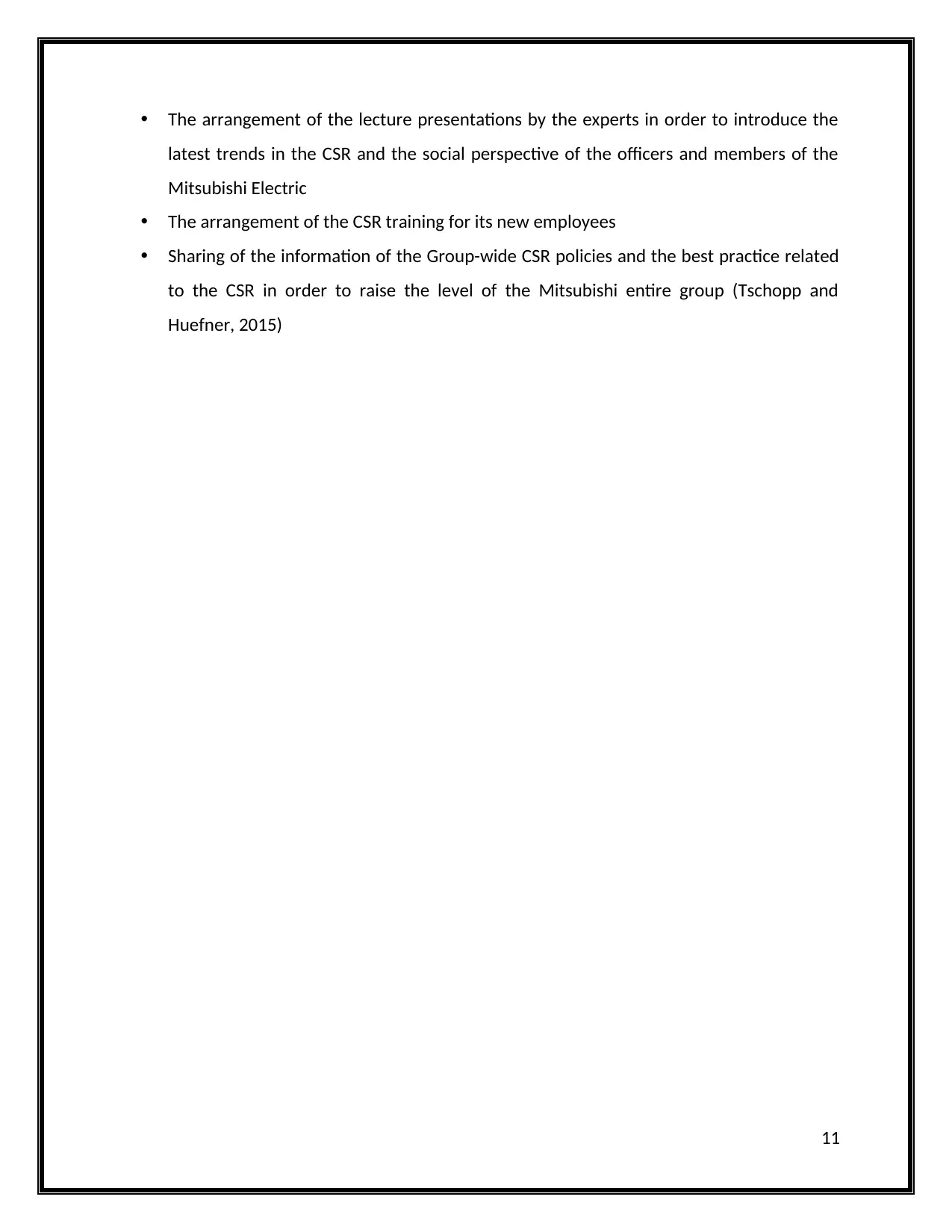
The arrangement of the lecture presentations by the experts in order to introduce the
latest trends in the CSR and the social perspective of the officers and members of the
Mitsubishi Electric
The arrangement of the CSR training for its new employees
Sharing of the information of the Group-wide CSR policies and the best practice related
to the CSR in order to raise the level of the Mitsubishi entire group (Tschopp and
Huefner, 2015)
11
latest trends in the CSR and the social perspective of the officers and members of the
Mitsubishi Electric
The arrangement of the CSR training for its new employees
Sharing of the information of the Group-wide CSR policies and the best practice related
to the CSR in order to raise the level of the Mitsubishi entire group (Tschopp and
Huefner, 2015)
11
⊘ This is a preview!⊘
Do you want full access?
Subscribe today to unlock all pages.

Trusted by 1+ million students worldwide
1 out of 15
Related Documents
Your All-in-One AI-Powered Toolkit for Academic Success.
+13062052269
info@desklib.com
Available 24*7 on WhatsApp / Email
![[object Object]](/_next/static/media/star-bottom.7253800d.svg)
Unlock your academic potential
Copyright © 2020–2025 A2Z Services. All Rights Reserved. Developed and managed by ZUCOL.




